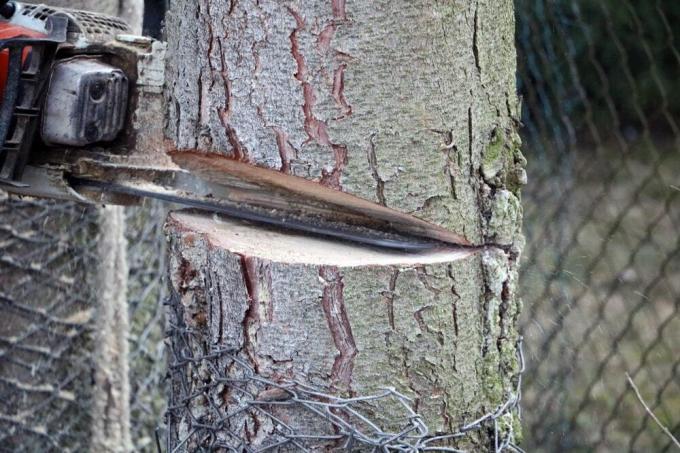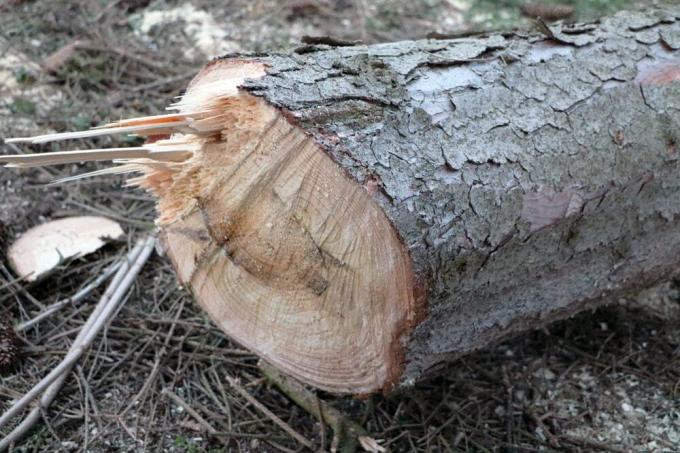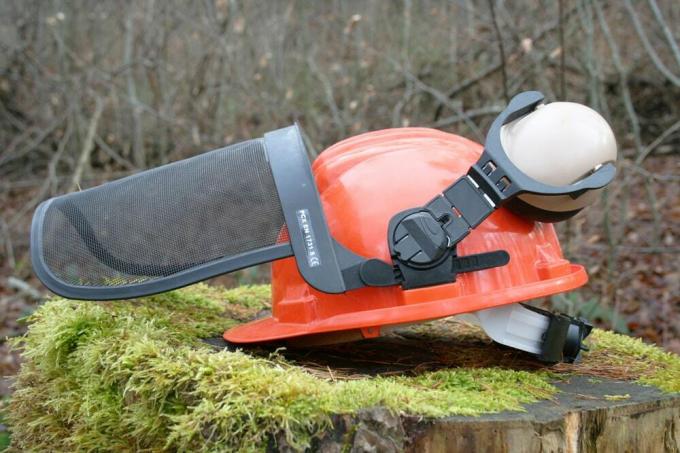

Table of contents
- basics
- Not subject to approval
- tree felling permit
- border trees
- replacement plantings
- application
- applicant
- application form
- application processing
- processing time
- period of validity
- Application in case of danger
- Costs
- felling times
- fines
- Safety measures
- Conclusion
Trees are one of the most important components of the ecosystem and are subject to certain protection. When and which trees you may cut down on your private property is regulated by the Tree Protection Ordinance. In many cases, a corresponding felling permit must be obtained from the responsible city or municipality. Here you should inform yourself about all the details in this regard, otherwise you may face high fines. From the application to exceptions to execution, the home garden guide explains how to proceed and what needs to be considered.
basics
If you want to cut down a tree on your property, you shouldn't just go ahead and do it if you don't know one or more of the following points:
- Does the affected tree fall under the Tree Protection Ordinance?
- Are your reasons for legal logging sufficient?
- Do you have to apply for a felling permit beforehand?
- Is an express application possible in an “emergency”?
Not subject to approval
Although the conditions for the obligation to have a tree felling permit vary from city to city or municipality as a rule, fruit trees and trees with a trunk circumference of less than 60 centimeters do not require a permit excluded. Most conifers are also exempt from this. The state forest law is responsible for trees in a forest area, which is why no felling permit from the city/municipality has to be obtained here.
But be careful, because as mentioned, the regulations differ, as the following examples illustrate:
- Berlin requires a tree felling permit from a tree circumference of 80 centimeters at a height of 1.30 meters, but provides it all deciduous trees including fruit trees, Scots pine and walnut trees as well as the Turkish tree hazel among the approval requirement.
- Brandenburg only allows tree felling that does not require a permit as an exception
If you are not quite sure and/or the tree trunk is just under the required trunk diameter limit, you should in any case inquire with the competent authority and the tree protection ordinance applicable to your place of residence see. Especially with the dimensions of the trunk, there can quickly be minimal measurement differences if a representative of the authority takes the measurement and meticulously insists on 60 centimetres. But if you have already liked it, it can cost you dearly. Therefore, when in doubt, the following applies: first ask, then act.
tree felling permit

If the affected tree with its respective properties or as its species falls under the tree protection ordinance applicable to the location, a felling permit must be applied for before each felling.
This must be granted by the competent authority if the following criteria are met:
- The tree is sick
- In the event of danger to persons or property
- The tree has mostly lost its ecological function
- Disturbance in the implementation of monument protection measures
- No species-typical development due to the current location is possible
- A permissible land use is prevented by the tree
- The development of further tree stocks is hindered by the tree
It should be noted, however, that despite the obligation to issue a tree felling permit, you are subject to the burden of proof. This means that when you apply, you must provide the competent authority with verifiable evidence that one of the above-mentioned reasons justifying a felling permit is involved.
As a rule, there is an on-site appointment at which the tree is inspected in order to check the correctness of the reasons you have given. However, the assessment here is always at the discretion of the competent authority. If, for example, the sick tree is treatable and therefore curable, there is a good chance that you will not receive a felling permit. For this reason, the only way to get a tree felling permit is through the courts, which are numerous every year Process rejection notifications and decide when there is a non-species-typical development or a land use is restricted.
border trees
When it comes to the question “which trees are not allowed to be felled”, the boundary tree is at the top of the list. "Boundary trees" are understood to mean those that are located directly on the property lines of two neighboring properties. So do you want to fell a tree that is both on your property but the trunk is now up on the neighbor's property, you may not simply plant the tree without the neighbor's consent fell.
It is irrelevant whether you planted the tree and cared for it yourself for decades. As soon as a tree crosses the property line with its roots or trunk, ownership rights also pass to the neighboring property owner.
Is it a tree for which you need a tree felling permit and submit the application without a declaration of consent from the neighboring property, you run the risk of the application being rejected becomes. So don't forget to enclose the neighbor's declaration of consent when you apply, because at the latest during an on-site inspection by the authorities, this could otherwise lead to unwanted problems to lead.
If the neighboring property owner does not agree to felling, you can only sue for it in court. Conversely, the neighbor also has the right to want to remove a boundary tree.
replacement plantings
A tree felling permit may be subject to a condition that requires the planting of a new tree. The replacement tree does not necessarily have to be of the same species as the felled tree. As a rule, it only has to be a trunk-forming tree, although standard fruit trees are also recognized by the authorities.

If the conditions on the property permit, replacement planting should be carried out on it. If this is not possible, the city/municipality offers public green spaces on which you can meet the requirement for replacement planting. In some cases, the authority also agrees to a compensation payment. This money is used by the city/municipality for tree care or for the trees in public green spaces.
application
As a rule, the application for a tree felling permit must be submitted to the environmental, regulatory or nature conservation office of the municipality that is responsible for the location of the tree in question. A distinction is made as to whether the felling of trees is desired, for example due to construction work, illness or a dangerous situation.
applicant
Only authorized users and property owners on whose property the affected tree is located can apply for a tree felling permit. In the case of border trees, the consent of the property neighbor must be submitted with the application or a joint application must be submitted. Third parties are only permitted as applicants if they have a corresponding, legally valid power of attorney from the beneficiary or the property owner.
application form
The application for felling approval must always be made in writing. Many cities and municipalities offer an application form on their websites that can be easily downloaded and filled out online. Alternatively, a personal presentation can be used to submit an application, at which the responsible clerk prepares the application and the applicant merely signs it leaves.
- Information/Documents Required
- property situation
- Property boundary and parcel number
- Type and precise size of tree to be felled
- trunk circumference
- crown diameter
- Naming the reasons for the desired tree felling
- Photos of the tree and, if applicable, of the immediate surroundings
- Optimal: Plot sketch with marked location of the tree
Tip:
The more extensive, precise, meaningful and complete your information and documents are when submitting the application, the faster the application can usually be processed.
application processing
If the authority has received the signed application with any documentary evidence, an on-site appointment will be arranged in many cases. Here, a representative of the authorities examines the conditions at the location of the affected tree in order to be able to assess whether the tree has matured.
processing time
A processing time of three weeks is provided for the tree felling permit. However, this period does not begin until all the required information and documents have been submitted in full to the authority. If the deadline has passed and you have not received a rejection letter, your application is usually considered approved.
period of validity
A granted felling permit is valid for one year. However, the blocking times must be taken into account here, during which no felling may be carried out, even despite a felling permit. Exceptions only exist if special permits have been granted for felling during the closed times.
If the affected tree has not been felled during the validity period of one year, an informal application can be made for an extension of another year.
Application in case of danger
If there is an acute danger from a tree, you can do without it in many communities become active before submitting an application if this means that you are endangering people or property ban. This means felling parts of a tree or a whole tree if it or parts of it threaten to fall over onto paths, streets or parking lots or the like. However, after (partial) felling has taken place, an application must be submitted to the authority with appropriate justification and explanation of the dangerous situation and ideally submission of photos.

In some regions, an informal application must be submitted quickly to the responsible public order office, which will make a decision quickly if there is imminent danger.
Costs
A tree felling permit is subject to a fee, whereby the application already requires a fee, which is to be paid in principle even after a felling permit has been rejected. The amount of the so-called administration fee depends on the respective municipality, which sets the prices. Depending on the location of the tree, costs between 25 euros and 85 euros can be expected.
You have to assume additional costs if you hire a specialist company for tree felling and root removal. The cost of felling a 15 meter high tree without removing the roots is between EUR 250 and EUR 1,000. In addition, there may be additional costs for heavy equipment for root clearing or lifting platforms. It is always worthwhile to get several comparison offers, because the price differences can be immense.
felling times
Once the tree felling permit has been granted, you still can't just start sawing it. Whether included in the respective tree protection regulations or not, there are nationwide blocking times for tree felling. These are regulated by the Federal Nature Conservation Act according to Section 39. This refers to the protection of wild animals and plants and prohibits any tree felling in the period between 01.01. March and the 30th September. Accordingly, felling permits are usually only granted between 01. October and 29 issued February. However, applications are accepted outside of the blocking periods.
A granted felling permit valid for one year changes it here, unless it is a Additional note available that for certain reasons a tree felling within the blocking period permitted. This is the case, for example, if the tree poses a danger to people or property.
fines
If you violate the Tree Protection Ordinance or other protective provisions and fell trees that require approval without the consent of the authorities, do not comply with the blocking periods or carry out tree felling improperly, you face fines of between 50 euros and 50,000 euros. How high the fines are for which violation of law or regulation depends on the respective federal state in which the matter is punished.
Safety measures
If you decide to use a chainsaw yourself to fell a tree, you are obliged to ensure appropriate safety when felling a tree. This includes safeguarding a danger area that is large around the tree to be felled. If you do not comply with these safety measures and damage to property or personal injury occurs within the danger area, you cannot only Assumption of damage costs, compensation for pain and suffering or other compensation payments, but also have to be fined calculate.

In order to protect yourself or other helpers, a certain basic knowledge and some experience of tree felling and technical tools are essential. Furthermore, you should never go to work without appropriate protective clothing. This includes at least:
- saw protection pants
- Protective helmet with visor
- ear protection
- safety shoes
- working gloves
- commission company
In principle, it is recommended to carry out tree felling work after a tree felling permit has been granted to have a specialist company do it if you do not have sufficient knowledge and experience yourself feature. While this comes at an additional cost, it relieves you of the responsibility and saves you a lot of the work involved in felling trees.
The specialists know all possible dangers and protect themselves and the environment accordingly. Fall calculations are part of your everyday life when it comes to ensuring that sufficient space is available or created so that the tree does not damage anything or anyone when it falls. If you don't know your way around here, you run a high risk that the tree will not fall in the exact direction that was hoped. In the case of unprofessional tree felling, it is not uncommon for cars, gutters, the neighboring fences or the garden house to be the "victims" of thicker and heavier trees. Ultimately, placing the order with a specialist company is probably the cheaper option.
Conclusion
Whenever you consider felling a tree, remember that you may need a permit to do so. You can find out in detail which trees are not allowed to be felled and which are authority and the respective tree protection ordinance that applies to the municipality in which the tree is located located. If you risk felling a tree without a permit, it could cost you significantly more than a felling permit. It is therefore better to inquire first and submit an application than to have to experience an immensely nasty financial surprise.
 garden editorial
garden editorial I write about everything that interests me in my garden.
Learn more about shrubs and woody plants

17 flowering hardy plants May to October
Many plants only show their full splendor for a short time. But there are also types and varieties with a particularly long flowering period from May to October, sometimes even longer. We present 17 flowering hardy plants.

25 hardy and evergreen ornamental trees
Ornamental trees are among the most popular plants in the garden. They have a decorative effect and set special accents in the green oasis. If you are tired of the gray of the cold season, you can plant trees that are hardy and evergreen.

Is barberry poisonous? | What is to be considered?
With their dense growth, numerous thorns and evergreen foliage, barberries are one of the most popular types of plants for a hedge in the garden. Before cultivating the sour thorn family (Berberidaceae), many ask themselves whether the plant is poisonous.

Azalea location: 6 important criteria
Azaleas are a flowering addition to the garden or living room, as long as they are in the right location. In the following guide to azaleas, we will tell you what to look out for.

How fast does a rhododendron grow? | Information about growth
How fast a rhododendron grows depends on various factors, including the variety, location and care. Growth can be accelerated under optimal conditions, while deficiencies lead to stunted growth.

Butterfly bush: the ideal location | Buddleia
The uncomplicated, easy-care and robust butterfly bush is suitable in the garden for borders, a flowering hedge or as a solitaire. Dwarf summer lilacs are ideal for pot culture. Buddleia bloom from June to October and are a magnet for many butterflies.



